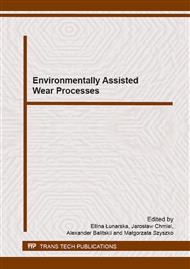[1]
B.M. Lar'kin, I.L. Rosenfeld: Protection of metals. Vol. 12 (1976), p.259 (in Russian).
Google Scholar
[2]
B.M. Lar'kin, I.L. Rosenfeld: Protection of metals. Vol. 13 (1977), p.170 (in Russian).
Google Scholar
[3]
B.M. Lar'kin, I.L. Rosenfeld: Protection of metals. Vol. 14 (1978), p.643 (in Russian).
Google Scholar
[4]
G.S. Beloglazov, M.I. Vakhrin and V.P. Polyudova, in: Application of corrosion inhibitors in national economy: Proc. Sci-tech. Seminar (Chelyabinsk Regional Society for Science & Technics, Russian Federation 1983), p.19 (in Russian).
Google Scholar
[5]
G.S. Beloglazov, M.V. Gryaznova and S.M. Beloglazov, in: EUROCORR 2004. Nice, France (2004), p.37.
Google Scholar
[6]
G.S. Beloglazov, A.A. Myamina and S.M. Beloglazov, ibid., p.39.
Google Scholar
[7]
G.S. Beloglazov: Materials Science. Vol. 12 (2012), p.5. doi: 10. 2478/v10077-012-0004-5, http: /dx. doi. org/10. 2478/v10077-012-0004-5.
Google Scholar
[8]
G.S. Beloglazov: Organic inhibitors of corrosion of metals: quantum chemical study (also inhibitors of hydrogen absorption by steel) (Lambert Academic Publishers, Germany 2013). ISBN 978-3-659-39656-4.
Google Scholar
[9]
G.S. Beloglazov: ViSyMoDiD – software for visualizing polyatomic molecular systems with features of showing absolute and differential electron distribution for the sub-systems together with dipole moment vector and 3 independent automatic rotations. Information on http: /ViSyMoDiD. ucoz. net (2013).
Google Scholar
[10]
S.A. Teryusheva, G.S. Beloglazov and S.M. Beloglazov: Solid State Phenomena. Vol. 183 (2012), p.249. ISBN 978-3-03785-320-7.
Google Scholar
[11]
V. Mukhomorov: Chem. Rapid Communications. Vol. 1 (2013), p.15 (2325).
Google Scholar
[12]
J.A.S. Smith, G.S. Beloglazov and N. Pierson, in: Proc. Perm State Uni. Phys. Perm, Russia: Perm State univ. Vol. 4 (1995), p.218 (in Russian).
Google Scholar
[13]
V.I. Vigdorovitch, L.E. Tsygankova: Inhibiting hydrosulhuric and carbon-dioxide corrosion of metals (Kartek, Russia, 2012) (in Russian).
Google Scholar
[14]
S.M. Beloglazov: Electrochemical hydrogen and metals: absorption, diffusion, and embrittlement prevention in corrosion and electroplating (Nova Science Publishers, Inc., USA, 2011).
Google Scholar
[15]
T. Clark: A Handbook of Computational Chemistry (Wiley-Interscience, USA, 1985).
Google Scholar
[16]
J.B. Foresman, A. Frisch: Exploring chemistry with electronic structure methods: a guide to using Gaussian. (Gaussian, Inc., USA, 1993).
Google Scholar
[17]
Gaussian, Inc.: Gaussian 94. Revision E03. M.J. Frisch, G.W. Trucks e. a. (1993).
Google Scholar
[18]
N.V. Kolesnikova: Influence of ureides derivatives on electrodeposition of alloy Ni-Mn and its corrosion at presence sulfate reducing bacteria and absorption of hydrogen. [Thesis] (Kaliningrad State university, Russia, 2004) (in Russian).
Google Scholar
[19]
H.H. Dunken, Ch. Opitz: Z. Chem. Vol. 6 (1966), p.390.
Google Scholar
[20]
V.F. Traven: Electronic Structure and Properties of Organic Molecules (Khimia/Chemistry, Russia, 1989) (in Russian).
Google Scholar
[21]
A.S. Kabankin, L.I. Gabrielyan: Chemical Pharmaceutical Journal. Vol. 42 (2008), p.30 (in Russian).
Google Scholar


